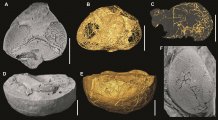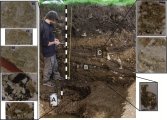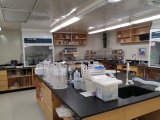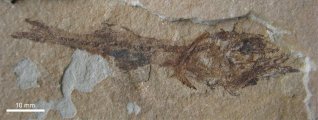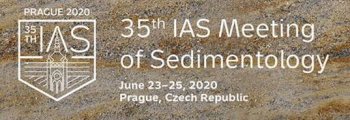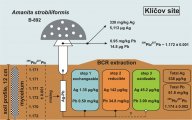News archive
News older than one year.
Traces of substrate feeding inside shells of dead animals in the context of Great Ordovician Biodiversification Event
The study of several thousand Ordovician (i.e., early Palaeozoic) fossils, mostly trilobites, bivalves, gastropods and echinoderms, demonstrated that most carcasses have become a subject of systematic and sophisticated feeding since the Mid Ordovician. Feeding traces have been preserved as thin tunnels insubstrate inside shells of dead organisms. For a certain period, the substrate had been enriched by microbial consortia; firm fibrous tissues could function as the source of organic matter. Feeding patterns tend to recur for each fossil group; thereby, the positions and shapes of certain non-preserved tissues can be estimated. The above mentioned complex feeding strategies appeared around the GOBE (i.e., Great Ordovician Biodiversification Event) which occurred mainly from 465 to 460 Ma. Paper.
A story of a ditch
The use of settlement space at Celtic oppida is related to the understanding of the sustainability of the functioning of a particular culture. These questions are becoming increasingly topical nowadays. This issue has been long in the focus of a geoarchaeological team also working on the Czech Science Foundation project "Oppidum as an Urban Landscape: Multidisciplinary Approach to the Exploration of Spatial Structure intra muros", the member of which is Assoc. Prof. Lenka Lisá of the Institute of Geology CAS. Recently, they published a study in the international journal Plos One (IF 2.776). This study discusses questions connected with the function of the ditch delimiting the enigmatic part of the Celtic oppidum of Bibracte in SE France. For additional details see here.
The first IAS Meeting of Sedimentology to be held in the Czech Republic rescheduled for June 22–24 2021!
The 35th IAS (International Association of Sedimentologists) annual meeting will be held in the Czech republic for the first time in entire IAS history. The Institute of Geology of the CAS participates in its organization. The meeting will be held in the Vienna House Diplomat Prague hotel on June 22–24, 2021. The total number of participants is expected between 700–1000 including leading scientists in the field of sedimentology.
Key themes and special sessions cover different processes leading to the origin of sedimentary rocks. Modern approaches and methods will be discussed which study sedimentary rocks as archives recording environmental changes in geological past, however, with implications for the present. All information is available at the Meeting website.
Success in Fulbright–Masaryk Scholarship
Ladislav Polák obtained the Fulbright–Masaryk Scholarship for a period of six months in the category of Ph.D. student. The research is being conducted at University of South Carolina from September 2019 to April 2020 and deals with iron and hafnium isotopes in carbonatites. Ladislav Polák actively participated in a student conference held in the Belle W. Baruch Institute for Marine & Coastal Sciences and in the Fulbright Conference at Furman University organized for Fulbright scholars from South Carolina and Georgia.
A new genus and species of fossil tubeshoulder fish
A new publication describes the first and the only articulated fossil specimen of tubeshoulder fish of the family Platytroctidae (order Alepocephaliformes). This remarkable fish inhabits deep-water environment and the specimen described has been found in the Menilitic Formation deposits (Oligocene) exposed in the vicinity of Kelč (Moravia). The specimen is housed in the collection of the National Museum in Prague. The fish represents a new genus and species. Its scientific name Vachalia moraviensis honours the outstanding Czech graphic and painter Josef Váchal, who died fifty-one years ago.
Magda Konzalová celebrated her 85th birthday
Our colleague RNDr. Magda Konzalová, CSc. celebrated her 85th birthday on February 16, 2020! She studied Tertiary sediments in boreholes from the Most Basin from palynological point of view. However, she also studied the first Proterozoic biota in cooperation with prof. Z. Pouba. She was working for the Institute of Geology of the Czech Academy of Sciences, Department of Paleobiology and Paleoecology from 1969 to 2006. We wish her good health and happiness for the coming years!
35th IAS Meeting of Sedimentology held in Prague for the first time!
The 35th IAS (International Association of Sedimentologists) annual meeting will be held in the Czech Republic for the first time in the entire IAS history. The Institute of Geology of the CAS participates in the organization. The meeting will be held in June 23–25, 2020 in Vienna House Diplomat Prague hotel. The total number of participants is expected between 700–1 000 including leading scientists in the field of sedimentology. Key themes and special sessions cover different processes leading to the origin of sedimentary rocks. Modern approaches and methods will be discussed which study sedimentary rocks as archives recording environmental changes in geological past, however, with implications for the present. All information is available at the Meeting website.
Potential use of of artificial intelligence and neural networks in geosciences
RNDr. Tomáš Hrstka PhD. was invited as a keynote speaker to the international expert forum EIT Raw Materials Expert Forum of the EU (Expert Forum: Digitalisation in the Raw Materials Sector) to present the possible applications of artificial intelligence and neural networks in geosciences and sustainability. Moreover, he also presented new findings based on the project Strategy AV21 related to the use of automated scanning electron microscopes in the study of individual dust particles and environment monitoring.
Surprising evidence of Ordovician rocks in the oldest part of the Lesser Himalayas
A conclusion on the presence of Ordovician rocks was expressed by the group of Indian geologists co-operating with ichnologist Radek Mikuláš of the Institute of Geology, Czech Academy of Sciences. The Lesser Himalaya mountain belt has been as yet considered to be built from Proterozoic and earliest Palaeozoic (Cambrian) rocks. However, newly collected rich assemblages of trace fossils (i.e., traces after activity of invertebrate organisms) contained in certain portions of the tectonically isolated block of the Nigali Dhar Valley contain trace fossils from the so-called Cruziana rugosa Group, which are considered typically Ordovician in age. They have been reported from epeiric seas of the former Gondwana Supercontinent. The finds, therefore, represent evidence of prolongation of the Ordovician Gondwana sea to the Indian continental tectonic plate.
The European Pince Cone Lepidella and silver
The European Pince Cone Lepidella (Amanita strobiliformis) is a fungus hyperaccumulating silver in sporocarps, with concentrations exceeding even 1,000 mg/kg in dry weight. Despite this fact, it grows in soils with natural Ag concentrations below 1 mg/kg. In the recent paper published in the Science of the Total Environment, the team of the Institute of Geology CAS focused on two populations of A. strobiliformis in Prague in co-operation with researchers from the Nuclear Physics Institute CAS, University of Chemistry and Technology, Institute of Microbiology CAS, and Jan Evangelista Purkyně University in Ústí nad Labem. The distribution of mycelium below sporocarps was investigated by the use of the quantitative polymerase chain reaction (qPCR). Lead isotopic fingerprinting was used to trace the metal transfer from soil to the sporocarps. According to the results, silver is likely accumulated from the 12 cm thick topsoil layer. At the site of Klíčov, a minimum soil volume of 0.006 to 0.079 m3 is required per sporocarp to accumulate the corresponding amount of Ag which represents a minimum area of 0.05 to 0.65 m2.


